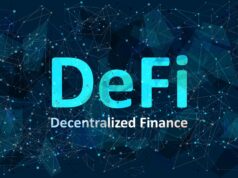Ethereum has always been in second place after Bitcoin, which rapidly established itself as a store of value after its release on the market. The first cryptocurrency already went through considerable decentralization, volatility and regulation issues, but through its community and expansions, it might soon be adopted as legal tender worldwide.
On the other hand, Ethereum is facing troubles despite being one of the most influential blockchains and ecosystems where vast tools are provided for creating dApps, DAOs and NFTs. Consequently, the Ethereum price USD is frequently affected by the fall of its digital environment due to a lack of safety and trust from investors.
To overcome most issues, Vitalik Buterin, the creator of Ethereum, developed an updated roadmap that would provide frequent upgrades to the blockchain and network in order to solve problems related to gas fees, sustainability and congestion. But what about centralization risks?
Demand for dApps and DeFi affected by dangers
In a recent attack, a hacker considerably altered the swap prices on a decentralized exchange by exploiting liquidity bugs. Besides regular assets, numerous DeFi applications were used and controlled, increasing the general public’s fear of their investments. Hence, the demand for these tools decreased considerably.
Unfortunately, as safe as it wants to be, the crypto environment is prone to scams and market manipulations, which is why fewer investors are confident in dApps or DeFi. This undoubtedly affected Ethereum prices and volatility, experiencing sudden spikes in costs.
On-chain data leads to proof of further problems
Decreasing fees, weak prices and regulatory challenges raise questions about whether Ethereum is ready to face this season. Indeed, the competition is getting stronger, and with the SEC being against all cryptocurrencies, it gets pretty tricky to mitigate problems.
These problems also remind investors that Ethereum still struggles with scalability since numerous updates are being developed to solve it. With an increasing number of users on the platform and current market conditions, we don’t know if Ethereum will soon be scalable enough to ensure gas fees are not astronomical and transaction processing doesn’t take weeks to complete.
Vitalik Buterin considers decentralization essential
In a recent interview, the creator of Ethereum emphasized how the staking process on the blockchain needs to be more effective within mining pools, eventually ensuring decentralization. This is a notable observation since it has been discovered that only a few big staking pools hold a considerable number of coins, affecting crypto prices and trends.
Buterin discussed the following EIP update, Danksharding, which is set to increase the data map on the network, therefore improving scalability. He also proposed a new voting system that enhances democracy and eliminates hard forks.
The Dencun upgrade will also mitigate scalability problems
Another EIP update that’s considerably more expanded is set to occur at the beginning of 2024 in order to solve Ethereum’s challenges. The Dencun upgrade is a combined system that will take place in both the execution and consensus layers, therefore taking care of smart contract logic execution and the state of the network and the nodes.
The upgrade will be linked with additional patches, such as Devnet9 or Sepolia, supporting Ethereum’s roadmap in successfully reaching its goal. After this update, a few others are to come on a period of a maximum of ten years since they all take time for development and practical assessment.
A continuous challenging path for Ethereum
Unfortunately, Ethereum has numerous other issues that influence its security and trust. For instance, validators collected additional income from transactions after the Merge, which led to suspicions of censorship and centralization. Indeed, after the update, censorship was reduced by around 35% from 78% in 2022, a considerable improvement but not enough for such a prominent blockchain.
The increase in liquid staking is also an issue that occurred after the Merge since it became possible for investors to withdraw their assets. However, there’s a long road until that moment because staked tokens can’t be used for buying or selling, so users have to wait for the perfect moment to receive them, but they don’t have the chance to maximize profits.
Another post-Merge problem is that Ethereum became deflationary for a moment, affecting the supply, which leaves investors worried about the coin’s value over time. On the other hand, others wish for ETH to become more valuable due to deflation, which can’t be proved for the moment, so waiting is the only solution.
Will the Ethereum roadmap solve any problems?
Currently, Ethereum is still recovering after the Merge update. Although it came with plenty of benefits, such as making the blockchain more sustainable and switching from the outdated PoW to PoS, the Merge put the network and its investors in trouble for some time.
And it’s expected the same to happen during the next steps of the roadmap, where more important issues will be tackled. The Surge follows the Merge, intending to solve scalability challenges through rollups and data sharding. At the moment, we’re only preparing for this update, but more are announced.
The Scourge will deal with censorship and decentralization settlements, a considerable yet underrated aspect of how the blockchain developed. Then, the Verge will allow verifying blocks to be more accessible and fast to eliminate congestion. The Purge will reduce computational costs for nodes. This issue has been prominent in Bitcoin, especially where any type of user would have to invest in expensive mining rigs to make a sustainable and consistent profit. Finally, the Splurge will handle the rest of the fixtures that weren’t included in previous updates in order to finish the roadmap properly. However, things will not be that easy.
Wrapping up
Ethereum is going through tough times again, during which its creator likes to remind investors that centralization risks will be handled with further updates and efforts. However, the blockchain is prone to numerous dangers, from censorship to bias in staking pools. At the same time, the updating roadmap isn’t set to work as smoothly as many believe, so we should expect more challenges on the way.


















